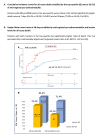Mid-regional pro-adrenomedullin and lactate levels for risk stratification in patients with out-of-hospital cardiac arrest
- PMID: 36943296
- PMCID: PMC10236520
- DOI: 10.1093/ehjacc/zuad029
Mid-regional pro-adrenomedullin and lactate levels for risk stratification in patients with out-of-hospital cardiac arrest
Abstract
Aims: Adrenomedullin (ADM) is a free-circulating peptide that regulates endothelial barrier function and vascular tone. Here, we sought to study the relationship of ADM in combination with lactate and the risk of death in patients with out-of-hospital cardiac arrest (OHCA).
Methods and results: Mid-regional pro-adrenomedullin (MR-proADM) and lactate concentrations were measured in patients with OHCA who survived at least 24 h after the return of spontaneous circulation. The outcome of interest was all-cause death. Patients were characterized by the quartiles (Q) of MR-proADM and lactate concentrations. Cox models were adjusted for age, sex, shockable rhythm, bystander resuscitation, simplified acute physiology score II (SAPS II), and estimated glomerular filtration rate (eGFR). A total of 232 patients were included in the present study (28% women, 67 years, SAPS II 80). The median MR-proADM and lactate levels at 24 h were 1.4 nmol/L [interquartile range (IQR) 0.8-2.8 nmol/L] and 1.8 mmol/L (IQR 1.3-3.4 mmol/L), respectively. Mid-regional pro-adrenomedullin concentrations correlated weakly with lactate levels (r = 0.36, P < 0.001). High (Q4) vs. low (Q1-Q3) MR-proADM concentrations were significantly associated with an increased rate of death at 28 days (75.9 vs. 45.4%; P < 0.001). After multivariable adjustment (including lactate levels at 24 h), higher MR-proADM levels were significantly associated with an increased risk of death [Q4 vs. Q1-Q3: adjusted hazard ratio (adj-HR) 1.67, 95% confidence interval (CI) 1.12-2.50; adj-HR for a 1-unit increase in a standardized biomarker 1.44, 95% CI 1.19-1.73]. This relationship remained significant even after further adjustment for baseline NT-proBNP and high-sensitivity troponin T levels. The combination of high MR-proADM and high lactate (Q4) concentrations identified patients at a particularly elevated risk (adj-HR 3.50; 95% CI 1.92-6.39).
Conclusion: Higher MR-proADM concentrations are associated with an increased risk of death in patients with OHCA, and the combination of high MR-proADM and lactate levels identifies patients at a distinctly elevated risk.
Keywords: Lactate; MR-proADM; Out-of-hospital cardiac arrest; Risk stratification.
© The Author(s) 2023. Published by Oxford University Press on behalf of the European Society of Cardiology.
Conflict of interest statement
Conflict of interest: T.A.Z. reports grants from the Austrian Science Funds and the German Research Foundation, honoraria for serving on advisory boards from Boehringer Ingelheim, and personal and lecture fees from Alkem Lab. Ltd, AstraZeneca, Bayer AG, Boehringer Ingelheim, and Sun Pharmaceutical Industries, and educational grants from Eli Lilly and Company. E.G. reports lecture fees from Daiichi Sankyo, AstraZeneca, and Roche Diagnostics. He has received honoraria for consultancy from Roche Diagnostics, Boehringer Ingelheim, Novo Nordisk, Brahms Deutschland, and Daiichi Sankyo. N.F. reports honoraria for serving on advisory boards from Boehringer Ingelheim, and lecture fees from AstraZeneca, Bayer, Novartis, and Pfizer. D.S., F.H., S.St., P.S., S.Sp., G.M., and M.R.P. report no conflicts of interest.
Figures





References
-
- Hypothermia after Cardiac Arrest Study Group . Mild therapeutic hypothermia to improve the neurologic outcome after cardiac arrest. N Engl J Med 2002;346:549–556. - PubMed
-
- Peek GJ, Mugford M, Tiruvoipati R, Wilson A, Allen E, Thalanany MM, et al. . Efficacy and economic assessment of conventional ventilatory support versus extracorporeal membrane oxygenation for severe adult respiratory failure (CESAR): a multicentre randomised controlled trial. Lancet 2009;374:1351–1363. - PubMed
-
- Guglin M, Zucker MJ, Bazan VM, Bozkurt B, El Banayosy A, Estep JD, et al. . Venoarterial ECMO for adults: JACC scientific expert panel. J Am Coll Cardiol 2019;73:698–716. - PubMed
-
- Desch S, Freund A, Akin I, Behnes M, Preusch MR, Zelniker TA, et al. . Angiography after out-of-hospital cardiac arrest without ST-segment elevation. N Engl J Med 2021;385:2544–2553. - PubMed
-
- Nolan JP, Neumar RW, Adrie C, Aibiki M, Berg RA, Bottiger BW, et al. . Post-cardiac arrest syndrome: epidemiology, pathophysiology, treatment, and prognostication. A scientific statement from the International Liaison Committee on Resuscitation; the American Heart Association Emergency Cardiovascular Care Committee; the Council on Cardiovascular Surgery and Anesthesia; the Council on Cardiopulmonary, Perioperative, and Critical Care; the Council on Clinical Cardiology; the Council on Stroke. Resuscitation 2008;79:350–379. - PubMed
MeSH terms
Substances
Grants and funding
LinkOut - more resources
Full Text Sources
Research Materials
Miscellaneous

